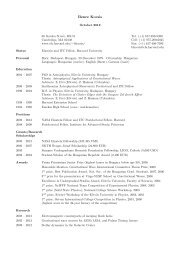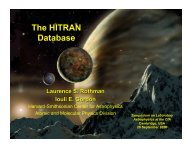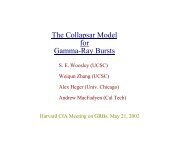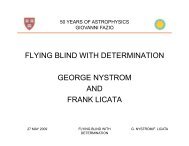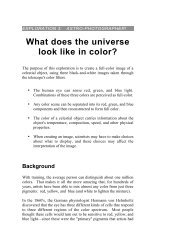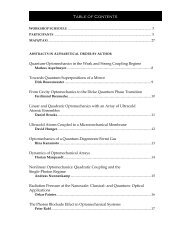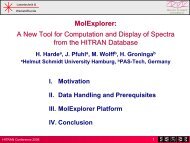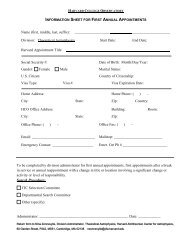High School Chemistry Content Background of Introductory College ...
High School Chemistry Content Background of Introductory College ...
High School Chemistry Content Background of Introductory College ...
You also want an ePaper? Increase the reach of your titles
YUMPU automatically turns print PDFs into web optimized ePapers that Google loves.
Research: Science and Education<br />
studied before the second quarter <strong>of</strong> the academic year. However,<br />
in college chemistry, students need to master stoichiometric<br />
calculations very early, <strong>of</strong>ten by the first or second week<br />
<strong>of</strong> the first course. In college chemistry textbooks, the topic<br />
is generally introduced by the third chapter. Some high school<br />
chemistry curricula and textbooks have chosen to take a qualitative<br />
or conceptually-based approach, de-emphasizing stoichiometry.<br />
The study <strong>of</strong> stoichiometry necessarily includes<br />
the application <strong>of</strong> mathematics, which also appears as a highly<br />
significant predictor <strong>of</strong> college performance.<br />
The influence <strong>of</strong> mathematics is evident in light <strong>of</strong> the<br />
significance <strong>of</strong> three predictors: HS Calculus Enrollment<br />
(regular, Advanced Placement A/B, or B/C), SAT–Math<br />
score, and Last HS Mathematics Grade as predictors. A surprising<br />
finding is the importance <strong>of</strong> calculus enrollment. Why<br />
does calculus appear to be so valuable in introductory college<br />
chemistry, especially since courses typically require few,<br />
if any, calculus applications? Our view is that facility with<br />
solving simple equations and comprehending graphs, an essential<br />
skill in college chemistry, over time and with practice.<br />
While advanced mathematics is not used in introductory<br />
chemistry, studying topics such as calculus in high school<br />
raises the likelihood that students show fluency in algebra<br />
with no scaffolding or teacher-support. In college, students<br />
who have not acquired these skills with full mastery are at a<br />
substantial disadvantage, since chemistry pr<strong>of</strong>essors do not<br />
“hand-hold” students with weak mathematical skills. Instead,<br />
pr<strong>of</strong>essors assume that students enrolled in their classes possess<br />
the pr<strong>of</strong>iciency to follow lectures and comprehend text<br />
passages without assistance regarding mathematical symbols<br />
and equations. Lack <strong>of</strong> fluency in mathematics, the “language<br />
<strong>of</strong> science”, handicaps introductory chemistry students, just<br />
as being a tourist in a foreign land limits one’s experience if<br />
you do not know the local language.<br />
Taking this discussion a step further, we wondered<br />
whether college chemistry students would specifically mention<br />
the term “stoichiometry” on their own if asked about<br />
their chemistry learning experiences. Therefore, to provide<br />
some limited qualitative corroboration <strong>of</strong> our statistical findings,<br />
we searched supplementary post-survey emails from respondents<br />
who completed our original survey and granted<br />
us permission to contact them with follow up questions.<br />
Among others, students were asked the following question:<br />
What aspects <strong>of</strong> your high school chemistry course helped<br />
you most in college? The following are excerpts from the responses<br />
<strong>of</strong> six students that specifically used the term stoichiometry:<br />
I think stoichiometry gave a lot <strong>of</strong> kids trouble so I think<br />
my fairly strong background with that gave me a heads up.<br />
...stoichiometry—I learned that really well in high school<br />
and I remembered it all throughout chemistry.<br />
...knowledge about stoichiometry from high school chemistry<br />
helped me most.<br />
I’d have to say stoichiometry because quite a few people<br />
had problems with that.”<br />
...stoichiometry and the ability to apply conversions helped<br />
the most.<br />
...most helpful was the depth [with which] we covered<br />
stoichiometry....<br />
These responses summarize the impact <strong>of</strong> stoichiometry in<br />
college chemistry. For the high school chemistry teachers who<br />
choose to spend more time on stoichiometry and less time<br />
on other more advanced topics, the results support their decision<br />
and suggest that this practice gives their students a significant<br />
advantage in introductory college chemistry.<br />
Acknowledgments<br />
The authors would like to acknowledge Janice Earle,<br />
Barry Sloane, and Larry Suter <strong>of</strong> the National Science Foundation<br />
for their insight and guidance for Project FICSS and<br />
the contributions <strong>of</strong> Marc Schwartz, Zahra Hazari, John<br />
Loehr, Cynthia Crockett, Harold Coyle, Annette Trenga, and<br />
Michael Filisky who were invaluable to the production <strong>of</strong> this<br />
manuscript. Also, the review and comments <strong>of</strong> Tom Pratuch<br />
<strong>of</strong> Annadale <strong>High</strong> <strong>School</strong> <strong>of</strong> Annadale, Virginia and A. Ian<br />
Harrison <strong>of</strong> University <strong>of</strong> Virginia both led to significant<br />
changes and additions to this manuscript. Finally, we wish<br />
to acknowledge the contribution <strong>of</strong> the thousands <strong>of</strong> introductory<br />
college students and their pr<strong>of</strong>essors who took the<br />
time to thoughtfully complete the surveys and the pilot surveys<br />
that made this analysis possible.<br />
W Supplemental Material<br />
A method to deal with missing data and an analytical<br />
approach for using non-normally distributed variables are discussed<br />
in this issue <strong>of</strong> JCE Online.<br />
Notes<br />
1. These schools are a subset <strong>of</strong> 67 selected through stratified<br />
random sampling based on school size from a comprehensive list<br />
<strong>of</strong> nearly 1700 four-year colleges and universities in the United<br />
States. Since nearly half <strong>of</strong> all students attending four-year colleges<br />
and universities are enrolled in only 10% <strong>of</strong> the country’s higher<br />
institutions, stratified random sampling ensured that the sample<br />
would be nationally representative. The chemistry departments <strong>of</strong><br />
all selected schools were contacted and asked to participate. Instructors<br />
at 31 schools agreed.<br />
2. This format is by far the most ubiquitous and thus the format<br />
most likely to be experienced by introductory chemistry students.<br />
3. Though retrospective self-report surveys are very common<br />
and include the National Assessment <strong>of</strong> Education Progress and the<br />
National Educational Longitudinal Survey <strong>of</strong> 1988, limitations are<br />
important to consider and include accuracy and reliability. Conclusions<br />
from early research questioning accuracy and reliability (20)<br />
have shifted in light <strong>of</strong> more recent studies that suggest memory and<br />
recall can be quite reliable even over extended periods <strong>of</strong> time when<br />
contextual cues are provided (20–22). Other researchers (23–26) have<br />
identified several additional factors to improve recall that include:<br />
proper wording <strong>of</strong> questions, grouping questions into conceptually<br />
related sequences, providing contextual cues within the questionnaire,<br />
surveying students in situations and surroundings associated with<br />
the topic, and making the survey relevant to the students. The survey<br />
methodology accounted for all <strong>of</strong> these factors.<br />
4. Apart from revealing associations among the content topics,<br />
a correlation analysis provides some details regarding associa-<br />
1710 Journal <strong>of</strong> Chemical Education • Vol. 83 No. 11 November 2006 • www.JCE.DivCHED.org




